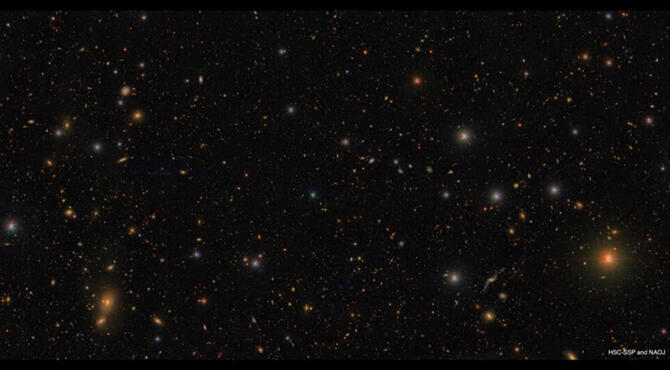An international collaborative research team from the Subaru Telescope's large‐scale imaging survey, the Hyper Suprime‐Cam Subaru Strategic Program (HSC‐SSP), used interim data from less than half of the survey to precisely measure the distribution of dark matter in the universe and test the standard cosmological model. The results confirmed, with a probability of over 95%, that the physical quantity (S8) obtained from the HSC‐SSP, which expresses the degree of progression of structure formation in the universe, does not agree with the S8 obtained from observations of the universe 380,000 years after the Big Bang. This result may indicate a rupture in the standard cosmological model, i.e., new physics in the universe. Further analyses using the final HSC‐SSP data and observations from the Subaru Telescope's next‐generation Prime Focus Spectrograph may resolve this issue.

Provided by NAOJ / HSC project
According to the Standard Model of Cosmology, the universe began with the Big Bang approximately 13.8 billion years ago and has been expanding ever since. The early universe was homogeneous and sparse; however, slight irregularities in the spatial distribution of matter, such as dark matter, increased due to gravity and created the structure of the current universe, including galaxies and galaxy clusters. Particularly, our Milky Way galaxy and other galaxies are thought to have formed where dark matter accumulated. The current universe is composed of around 5% ordinary matter, 25% dark matter, 70% dark energy, and a low percentage of photons.
The standard cosmological model of the universe, for which the composition of the present universe adds two parameters that characterize the primordial fluctuations (convexity and concavity of the spatial distribution of matter) that existed in the early universe, can explain much of the observational data. However, questions such as "did the Big Bang really happen?", and "what is the nature of dark matter and dark energy?", along with many other questions remain.
An international collaborative research team consisting of researchers from Japan, Taiwan, and the United States conducted a large‐scale imaging survey using HSC (HSC‐SSP) from 2014‐2021. The light from distant galaxies was distorted by the gravitational lensing of cosmic structures along the way. In contrast, by measuring the distortion of the distant galaxy image, the gravitational strength of the cosmic structure can be observed, revealing the spatial distribution of dark matter, which accounts for most of the gravity and cannot be observed directly with light. However, the distortions caused by gravitational lensing are extremely small and cannot be detected in individual galaxies.
The research team accurately measured the gravitational lensing effect of the universe by combining the shapes of approximately 25 million galaxies based on observations of around 420 square degrees (equivalent to 2,000 full moons) of the sky, which is approximately 3 years, or less than half, of the entire HSC‐SSP survey. From the measurement of the gravitational lensing effect, a physical quantity (S8) can be measured that indicates the degree of progress in the current structure formation of the universe. If the standard cosmological model is correct, S8 obtained from different observations should have the same value.
The HSC‐SSP results show that S8 is 0.76, which is consistent with the Western measurements of the gravitational lensing effect. In contrast, the S8 obtained using HSC‐SSP data is smaller than the S8 (0.83) obtained using the cosmic microwave background radiation measurement by the Planck satellite. This difference was predicted to result from measurement errors in the two observations, and the probability that the two S8 values led to the present result is less than 5%. As a result, there is a greater than 95% probability that the two measurements will not agree.
Since the Planck satellite observes the 380,000‐year‐old early universe, obtaining the value of S8 from its measurements requires evolving the structure to the present‐day universe using the cosmological parameters suggested by the Planck satellite results to calculate S8. The discrepancy may be due to a breakdown in the assumed standard cosmological model. It is possible that there are undetermined effects of physics in the universe that have not been included in the standard cosmological model.
Associate Professor Hironao Miyatake of the Kobayashi‐Maskawa Institute for the Origin of Particles and the Universe, Nagoya University, a member of the international collaborative research team said, "Analysis of data from the third year of the Subaru Telescope has made it more certain that there is a rupture in the standard cosmological model, which has remained unbroken for 20 years. In the future, we will be gradually entering a phase of searching for new physics that may emerge from the rupture of the standard cosmological model. I am very excited to continue working on this major problem together with the young researchers who have gained experience through this analysis."
This article has been translated by JST with permission from The Science News Ltd. (https://sci-news.co.jp/). Unauthorized reproduction of the article and photographs is prohibited.




